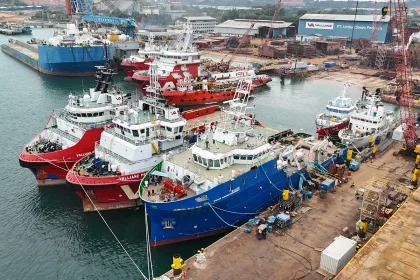Pedro Furtado, Deputy General Manager and Projects Director at Efacec speaks to APAC Outlook about the importance of sustainable warehousing in supply chains.
Sustainability is one of the latest industrial buzzwords. From the beauty industry to the pharmaceutical industry, and now to even the logistics industry, the concept of sustainability has firmly rooted itself in the minds and strategies of business people worldwide. And where supply chain logistics is concerned, sustainability is defined simply as looking into how various parts of a logistics network can be improved in terms of optimising environmental, waste, and business risk costs.
As globalisation intensifies, companies face several obstacles to expansion, including increasing global competition, growing consumer demands and expectations, rising manpower costs, increasing environmental regulations, and resource scarcity. In light of these challenges, the world is a smaller place than before, and by adopting environmental, social, and economic perspectives in strategy planning and execution, companies are seeking to harness sustainable, efficient measures to respond to challenges that abound in business landscapes.
THE ESSENTIAL WAREHOUSE
The warehouse is an important component of efficient sustainable supply chains. Regardless of what industry a warehouse serves, companies utilising warehouse logistics will do well to not view warehousing as simply a means to store raw materials and finished goods.
In order to maximise warehouse operation efficiency, savvy manufacturers today employ various forms of warehouse management systems (WMS). As a pillar of support within the logistics network, WMS are increasingly finding their place of importance within supply chains. The essence of a WMS stems from its ability to connect stores and distribution centres with warehouses, and to coordinate shipping and ground transport as well. Information is collected across these multiple logistic points and then compiled into a centralised database that companies can utilise to track inventory movement. Additionally, the visibility of the WMS enables companies to maintain inventory control and uncover areas for improvement.
Furthermore, companies will find that automated warehousing offers various opportunities to reduce the environmental and social footprints of warehouse facilities, in ways that in fact improve their business’ financial bottom line.
SUSTAINABLE WAREHOUSING – A THREE-PRONGED APPROACH
When it comes to creating sustainable value, there are several practices that warehouses can implement. Three such approaches include automating both warehouse solutions and management processes, increasing energy efficiency within a warehouse, and optimising warehouse design.
In addition to implementing WMS in their warehousing processes, companies will also do well to incorporate other automated solutions including order picking technologies (pick-to-light technology, voice technology, sortation systems, etc.), bar-coding, radio frequency identification (RFID), and automated storage and retrieval systems (ASRS) to achieve a sustainable warehousing system.
By automating labor-intensive processes, companies can achieve financial and business management sustainability benefits in the long run as improved inventory visibility can increase product accuracy and even influence customer satisfaction. For example, companies switching to bar-coding and RFID technologies will inevitably see a reduction in paper consumption as they adopt a largely digital approach, thus lending a hand to environmental sustainability along the way. A big concern in the logistics industry, traceability can also be better accounted for with automated warehousing systems. In the event of a product recall, the WMS will be able to provide companies with necessary details for efficient recall. Sustainable value is achieved as companies see less waste in terms of resources, time, and energy required to trace and recover products.
In the business landscape where competition is rife and there is an ever-present threat to survival, an ASRS could potentially help manufacturers cope with rising business pressures, increasing labour costs, intensified calls for safety, and the need for tighter security. On top of more productive sorting and retrieving processes, an ASRS is particularly useful in minimising the warehouse footprint as it offers innovative storage solutions. Utilising vertical space within a warehouse, ASRS are capable of handling and processing a higher volume of orders in a given period of time and space. ASRS can also help companies avoid unfavorable environmental impact that may result from constructing a new warehouse.
INCREASING ENERGY EFFICIENCY
Warehouses consume a large amount of energy within a regular logistics supply chain. However, automated warehousing solutions can be responsible for significant amounts of energy savings as they can function in both darkness and in non-heated environments. This is a stark contrast to conventional warehouse equipment that has high-energy consumption levels and high operating costs. For day-to-day operations in an automated warehouse, it is advisable to instil ‘lights-out operation’ as lights are generally required only during routine maintenance checks. Automated technologies such as stacker cranes can function independently without supervision, so it is unnecessary to cater for this expenditure.
Warehouses that integrate green warehousing practices such as daylighting technology (skylights, photocell sensors, etc.) will help companies to save energy costs in the long run. Some methods that can be used include fitting warehouses with solar panels or light emitting diode (LED) lighting, power regeneration by converting braking forces from automated equipment to electricity, and recovering heat that is generated from cold storage systems. Other methods include switching to natural ventilation instead of electrically-run ventilation, and even adjusting the speed of conveyors and palletisers so that when left unused, this equipment can run at a slower pace or be turned off.
In implementing energy-efficient warehousing measures, more than 20% of cost savings can be achieved. Companies adopting green warehousing practices can then work towards building a financially and environmentally sustainable business.
OPTIMISING WAREHOUSE DESIGN
Careful planning of the warehouse layout is not only crucial for companies to maximise workflow efficiency and remove unnecessary steps within the warehousing process, but it also helps to ensure that the warehouse can integrate new functions easily in the future. Companies should aim to maximise their cube-wise space – length, width, and height – to fully optimise the warehouse for efficient material handling, order picking and storage processes, accommodating personnel movement, and handling of equipment such as Automated Guided Vehicles (AGV). Inefficient use of warehouse space can lead to excess utility, unnecessary labour costs, and lower asset utilisation.
When constructing the layout, companies need to collect operation data on actual facility throughput, information on warehouse structure requirements such as loading and levelness, precision data on floor flatness, and even weather information as it relates to possible impact on warehouse structure durability. By incorporating these factors into the warehouse design, companies can then achieve energy efficiency and increase productivity.
FIRST STEPS TOWARDS WAREHOUSE SUSTAINABILITY
While it is clear to see that companies who incorporate sustainability initiatives in their warehouse can enjoy financial and environmental sustainability, it must be said that sustainability needs to be strategically managed and given top management support for actions to occur.
As the logistics industry continues to evolve, the three approaches highlighted above can be employed by companies to increase the positive effects of their business activities on the environment. And as a significant component in supply chains worldwide, the warehouse can be a competitive asset for businesses to achieve both financial and environmental sustainability objectives in the long-term.
By Pedro Furtado, Deputy General Manager and Projects Director at Efacec





































